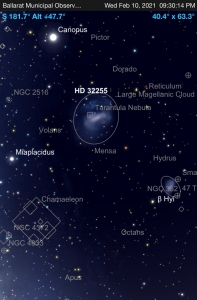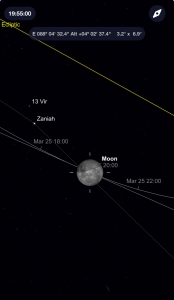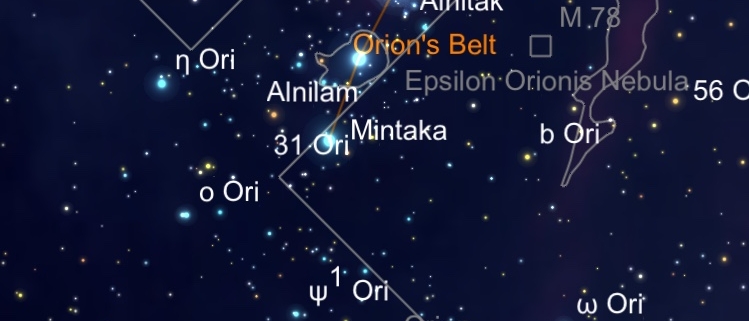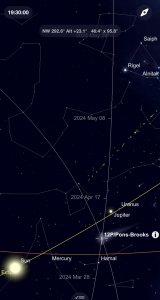What’s in the Sky in March
March
- 5th Moon at it’s highest altitude, 29 degrees South.
- 10th Moon at Perigee 16:04hrs AEDT, 356,893.9 km. A super Moon is when the Moon is less than 360,000km from Earth.
- 11th 5.30amAEDT ONLINE Watch Comet 12P/Pons-Brooks is putting on a show now in the NORTHERN HEMISPHERE ONLY, soon after sunset: the Virtual Telescope Project will share the view live, online. The live feed will start on 10 Mar. 2024, at 18:30 UTC, 05:30hrs AEDT in Ballarat. See April What’s in the Sky for a small window of time for possible viewing from Ballarat.
- 18th Luna lowest altitude 28 degrees North.
- 12th The Large Magellanic Cloud (LMC) reaches highest altitude about 9.00pm AEDT at magnitude 0.28. The LMC is a spiral galaxy in Dorado at a distance of 160kly and a diameter of 29.7kly in diameter. The Tarantula Nebula, NGC 2070 is located in this area and is magnitude 5. it is 1,833ly in diameter. The Small Magellanic Cloud (SMC) located nearby is a spiral Galaxy in Tucana and 200kly in distance and 17.5kly in diameter. visual magnitude is 2.29. These two irregular dwarf are members of our local group and are orbiting the Milky Way Galaxy.
- Kourtchin (Boorong) refer to the Magellanic Clouds as the male (LMC) and female (SMC), Brolgas. Each cloud resembles the colour and pitted shell of the Brolga egg. Brolgas breed from October to April , when the clouds are at their highest, extending into nearby stars the larger one is trumpeting and the smaller one displaying, but dancing as a pair towards each other.

- 20th Northward Equinox, 14:07hrs AEDT. The Sun crosses the Celestial Equator and moves into the Northern Hemisphere Sky.
-
A healthy 100-foot-tall tree has about 200,000 leaves. A tree this size can take 11,000 gallons of water from the soil and release it into the air again as oxygen and water vapor in a single growing season.* Native tree species support natural ecosystems by providing habitat and food for birds, mammals, and insects.* The planting of trees improves water quality. Tree’s complex root network reduces runoff and erosion. This allows more recharging of the ground water supply. Wooded areas help prevent the transport of sediment and chemicals into streams. Studies show up to 88 percent of nitrate and 76 percent of phosphorus is reduced after agricultural runoff passes through a forested streamside buffer.* In addition to all these things, forested streamside buffers also filter sediment from streams, stabilize streambanks, shade and modify stream temperatures, sequester carbon to help mitigate greenhouse gas emissions, and reduce downstream flooding. And the presence of mature trees in a buffer makes the stream wider.* A mature tree absorbs carbon dioxide at a rate of 48 pounds per year. In one year, an acre of forest can absorb twice the CO2 produced by the average car’s annual mileage.NONE of THE ABOVE OCCURS ON MARS OR ANY OTHER PLANET WE KNOW OF.
- 24th Luna Apogee, 2nd for this month, furthest distance from Earth for the month 02:43hr AEDT 406,259.2km.
- 25th Partial Eclipse of the Moon Image is at 7.55pm AEDT.



 Image April 11th positions.
Image April 11th positions.